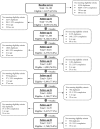Cohort profile: the British Columbia COVID-19 Population Mixing Patterns Survey (BC-Mix)
- PMID: 36002217
- PMCID: PMC9412046
- DOI: 10.1136/bmjopen-2021-056615
Cohort profile: the British Columbia COVID-19 Population Mixing Patterns Survey (BC-Mix)
Abstract
Purpose: Several non-pharmaceutical interventions, such as physical distancing, handwashing, self-isolation, and school and business closures, were implemented in British Columbia (BC) following the first laboratory-confirmed case of COVID-19 on 26 January 2020, to minimise in-person contacts that could spread infections. The BC COVID-19 Population Mixing Patterns Survey (BC-Mix) was established as a surveillance system to measure behaviour and contact patterns in BC over time to inform the timing of the easing/re-imposition of control measures. In this paper, we describe the BC-Mix survey design and the demographic characteristics of respondents.
Participants: The ongoing repeated online survey was launched in September 2020. Participants are mainly recruited through social media platforms (including Instagram, Facebook, YouTube, WhatsApp). A follow-up survey is sent to participants 2-4 weeks after completing the baseline survey. Survey responses are weighted to BC's population by age, sex, geography and ethnicity to obtain generalisable estimates. Additional indices such as the Material and Social Deprivation Index, residential instability, economic dependency, and others are generated using census and location data.
Findings to date: As of 26 July 2021, over 61 000 baseline survey responses were received of which 41 375 were eligible for analysis. Of the eligible participants, about 60% consented to follow-up and about 27% provided their personal health numbers for linkage with healthcare databases. Approximately 83.5% of respondents were female, 58.7% were 55 years or older, 87.5% identified as white and 45.9% had at least a university degree. After weighting, approximately 50% were female, 39% were 55 years or older, 65% identified as white and 50% had at least a university degree.
Future plans: Multiple papers describing contact patterns, physical distancing measures, regular handwashing and facemask wearing, modelling looking at impact of physical distancing measures and vaccine acceptance, hesitancy and uptake are either in progress or have been published.
Keywords: COVID-19; Epidemiology; Health & safety; PUBLIC HEALTH.
© Author(s) (or their employer(s)) 2022. Re-use permitted under CC BY-NC. No commercial re-use. See rights and permissions. Published by BMJ.
Conflict of interest statement
Competing interests: None declared.
Figures
Similar articles
-
British Columbia's COVID-19 surveys on population experiences, action, and knowledge (SPEAK): methods and key findings from two large cross-sectional online surveys.Can J Public Health. 2023 Feb;114(1):44-61. doi: 10.17269/s41997-022-00708-7. Epub 2022 Dec 2. Can J Public Health. 2023. PMID: 36459366 Free PMC article.
-
Quantifying the impact of COVID-19 control measures using a Bayesian model of physical distancing.PLoS Comput Biol. 2020 Dec 3;16(12):e1008274. doi: 10.1371/journal.pcbi.1008274. eCollection 2020 Dec. PLoS Comput Biol. 2020. PMID: 33270633 Free PMC article.
-
Association of a Public Health Campaign About Coronavirus Disease 2019 Promoted by News Media and a Social Influencer With Self-reported Personal Hygiene and Physical Distancing in the Netherlands.JAMA Netw Open. 2020 Jul 1;3(7):e2014323. doi: 10.1001/jamanetworkopen.2020.14323. JAMA Netw Open. 2020. PMID: 32639569 Free PMC article.
-
Social distancing policies in 22 African countries during the COVID-19 pandemic: a desk review.Pan Afr Med J. 2020 Dec 14;37(Suppl 1):46. doi: 10.11604/pamj.supp.2020.37.46.27026. eCollection 2020. Pan Afr Med J. 2020. PMID: 33552374 Free PMC article. Review.
-
[Impact of social distancing for covid-19 on youths' physical health: a systematic review of the literature.].Recenti Prog Med. 2021 May;112(5):347-359. doi: 10.1701/3608.35872. Recenti Prog Med. 2021. PMID: 34003187 Italian.
Cited by
-
Observed negative vaccine effectiveness could be the canary in the coal mine for biases in observational COVID-19 studies.Int J Infect Dis. 2023 Jun;131:111-114. doi: 10.1016/j.ijid.2023.03.022. Epub 2023 Mar 27. Int J Infect Dis. 2023. PMID: 36990200 Free PMC article.
-
The Impact of Mask Mandates on Face Mask Use During the COVID-19 Pandemic: Longitudinal Survey Study.JMIR Public Health Surveill. 2023 Jan 11;9:e42616. doi: 10.2196/42616. JMIR Public Health Surveill. 2023. PMID: 36446134 Free PMC article.
-
Social Contacts and Transmission of COVID-19 in British Columbia, Canada.Front Public Health. 2022 May 3;10:867425. doi: 10.3389/fpubh.2022.867425. eCollection 2022. Front Public Health. 2022. PMID: 35592086 Free PMC article.
-
Association between close interpersonal contact and vaccine hesitancy: Findings from a population-based survey in Canada.Front Public Health. 2022 Oct 4;10:971333. doi: 10.3389/fpubh.2022.971333. eCollection 2022. Front Public Health. 2022. PMID: 36267997 Free PMC article.
-
Ethnic Disparities in COVID-19 Vaccine Mistrust and Receipt in British Columbia, Canada: Population Survey.JMIR Public Health Surveill. 2024 Feb 16;10:e48466. doi: 10.2196/48466. JMIR Public Health Surveill. 2024. PMID: 38363596 Free PMC article.
References
-
- Johns Hopkins Coronavirus Resource Center . COVID-19 Map [Internet]. Available: https://coronavirus.jhu.edu/map.html [Accessed 23 May 2021].
-
- BC Stats . 2020 Sub-Provincial population estimates highlights, 2020.
-
- Joint statement on Province of B.C.’s COVID-19 response, latest updates |BC Gov News [Internet], 2020. Available: https://news.gov.bc.ca/releases/2020HLTH0089-000505 [Accessed 23 May 2021].
Publication types
MeSH terms
LinkOut - more resources
Full Text Sources
Medical
Research Materials

